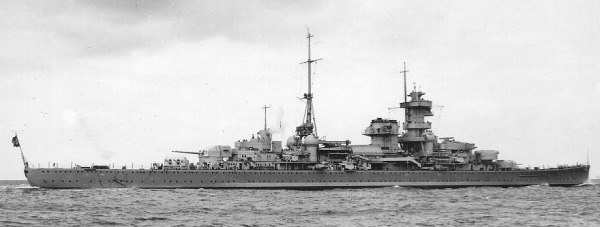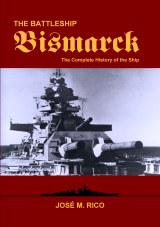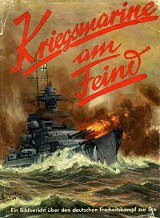 |
Home Intro Technical History Crew Models Gallery Kriegsmarine Archives
More Forum  UPDATES UPDATES |

30 October 1934: Ordered.
06 July 1935: Lay down on Slipway 9 at the Blohm & Voss Shipyard in Hamburg. Construction number B 501.
06 February 1937: Launched. Christened by Erika Raeder, wife of Generaladmiral Erich Raeder. The ship is named after Franz von Hipper, Admiral in the Imperial German Navy.
February 1939: In floating dry dock No. V-VI.
29 April 1939: Commissioned under Captain Hellmuth Heye.
July-September 1939: Modifications. Atlantic bow, funnel cap added.
18-20 February 1940: Operation Nordmark. Under the command of Admiral Wilhelm Marschall, Admiral Hipper together with the battleships Gneisenau, Scharnhorst, and eight destroyers make a brief sortie into the North Sea. The group returns safely to Wilhelmshaven. No special occurrences.
06 April 1940: Operation Weserübung. Participates in the invasion of Norway as part of "Group II" destined to Trondheim. The Admiral Hipper, with 900 soldiers of the 3rd Mountain Division on board, leaves Cuxhaven at night escorted by the destroyers Paul Jacobi, Friedrich Eckoldt, Bruno Heinemann, and Theodor Riedel, with 800 soldiers more.
08 April 1940: Collides with the British destroyer Glowworm (Lieutenant-Commander Gerard Broadmead Roope). As a result of the collision, that causes a 40-meter hull tear on the starboard side of Hipper, the Glowworm sinks. The Germans rescue 38 British survivors.
09 April 1940: Arrives in Trondheim.
10 April 1940: Daparts Trondheim in the evening bound for Germany.
12 April 1940: Arrives in Wilhelmshaven together with the battleships Scharnhorst and Gneisenau.
13 April-May 1940: Drydocked in Wilhelmshaven.
04 June 1940: Operation Juno. At 0700 hours leaves Kiel with Scharnhorst, Gneisenau, and the destroyers Erich Steinbrink, Hans Lody, Hermann Schoemann, and Karl Galster.
20 June 1940: At 1600 hours, Gneisenau, Admiral Hipper and four destroyers leave Trondheim for Iceland. Seven hours later, at about 40 miles northwest of the island of Halten, the Gneisenau is hit in the bow (sections XX-XXI) by a 21-inch MK VIII torpedo fired from the British submarine Clyde (Lieutenant Commander David C. Ingram). The German ships return to Trondheim.
21 June - 24 July 1940: Anchored in Trondheim.
25 July 1940: Departs Trondheim northbound to operate against Petsamo merchant traffic.
26 July - 08 August 1940: Operates in northern waters against merchant shipping supported by supply ship Dithmarschen. On 4 August, captures the Finnish steamer Esterthorden that is sent to Tromsø with a prize crew.
08 August 1940: Returns to Germany for a dockyard overhaul.
11 August 1940: Arrives in Wilhelmshaven.
04 September 1940: Captain Wilhelm Meisel takes over command of the ship.
30 November 1940: Departs Brunsbüttel for the Atlantic in order to carry out operations against merchant shipping.
05 December 1940: Refuels from tanker Adria.
07 December 1940: Passes through the Denmark Strait.
24-25 December 1940: At about 700 nm west of Cape Finisterre, Hipper finds convoy WS5A escorted by cruisers Berwick, Dunedin and Bonaventure, and carrier Furious. There is a naval engagement in which the Hipper obtains four hits on the Berwick before breaking contact. Expends 174 x 20.3cm and 113 x 10.5cm projectiles.
27 December 1940: Arrives in Brest.
January 1941: Drydocked in Brest.
01 February 1941: Departs Brest for another Atlantic sortie.
11 February 1941: Sights convoy SLS-64 and sinks seven ships totalling 32,806 GRT.
15 February 1941: Enters Brest.
15 March 1941: Leaves Brest and sails back to Germany via the Denmark Strait.
23-24 March 1941: Passes through the Denmark Strait.
26 March 1941: Joined by destroyers Z23 and Z24 from Bergen, that provide escort in the Skagerrak and Kattegat.
28 March 1941: Hipper arrives in Kiel.
April-October 1941: Undergoes a major overhaul at Deutsche Werke, Kiel.
18 March 1942: Passes through the Kiel Canal.
19-20 March 1942: Operation Eisenbahn. Admiral Hipper is transferred to Trondheim together with destroyers Z23, Z24, Z30, and torpedo boats T15 and T16.
02 July 1942: Operation Rösselsprung. At 1800, the Tirpitz leaves Trondheim under the command of Admiral Otto Schniewind and sails North, together with the heavy cruiser Admiral Hipper, the destroyers Friedrich Ihn, Hans Lody, Karl Galster, Theodor Riedel and the torpedo boats T7 and T15. Their mission is to join in Altafjord with the battle group from Narvik under the command of Vizeadmiral Oskar Kummetz and comprised of the heavy cruisers Lützow (ex-Deutschland) and Admiral Scheer, and the destroyers Z24, Z27, Z28, Z29, and Z30 to attack the convoy PQ17 with 36 merchantmen. During their voyage to Altafjord the destroyers Hans Lody, Karl Galster, and Theodor Riedel of the Tirpitz group run on to rocks and are discarded for the operation. The Lützow also runs on to rocks and returns to Narvik.
04 July 1942: Tirpitz's group joins Admiral Scheer's in Altafjord. At 2215 hours PQ-17 scatters.
05 July 1942: At 1100, Tirpitz, Scheer, Hipper, the destroyers Friedrich Ihn, Richard Beitzen, Z24, Z27, Z28, Z29, Z30, and the torpedo boats T7 and T15 leave Altafjord. The Soviet submarine K21 attacks Tirpitz with torpedoes at 1702, but obtains no hits. At 2130 the Germans cancel their mission and return home. In the end the German battle group does not engage the enemy, but the Luftwaffe and the U-boats manage to sink 22 merchantmen carrying 430 tanks, 210 planes, 3,350 vehicles and over 99,000 tons of material.
08 July 1942: The Fleet enters the Ofotfjord and anchors in Bogen Bay near Narvik.
10-11 September 1942: Admiral Hipper, Admiral Scheer and Köln, together with destroyers Z23, Z27, Z29, Z30, and Richard Beitzen, are transferred from Bogen Bay to Kåfjord/Altafjord.
24 September 1942: Operation Zarin. At 2100 hours, Admiral Hipper and destroyers Z23, Z28, Z29, and Z30 of the 8th Destroyer Flotilla, leave Altafjord for minelaying operations northwest of the Novaya Zemlya archipelago (quadrant AT 16).
28 September 1942: Admiral Hipper arrives at Kåfjord with the four destroyers in the morning.
October 1942: Transferred from Altafjord to Bogen Bay.
30 December 1942: Operation Regenbogen. The heavy cruisers Admiral Hipper and Lützow, together with destroyers Friederich Eckoldt, Richard Beitzen, Theodor Riedel, Z29, Z30, and Z31, all under the command of Vizeadmiral Oskar Kummetz, depart Altafjord to intercept convoy JW51B that has been previously reported by U-354 (Kapitänleutnant Karl-Heinz Herbschleb).
31 December 1942: Admiral Hipper receives considerable damage from the British cruisers Sheffield and Jamaica. Vizeadmiral Kummetz breaks off the action.
01 January 1943: The German squadron arrives in Altafjord.
23 January 1943: Admiral Hipper, Köln, and destroyers Richard Beitzen, Z29, and Z30 depart Altafjord southbound for Germany.
1-4 February 1943: At Fættenfjord near Trondheim.
07 February 1943: Admiral Hipper arrives in Kiel.
28 February 1943: Decommissioned.
17 April 1943: Towed to Pillau.
30 April 1944: Recommissioned and put into service with the Training Squadron in the Baltic.
30 January 1945: Hipper departs Gotenhafen with more than 1,500 refugees on board.
02 February 1945: Arrives in Kiel.
03 May 1945: Bombed in Kiel and later scuttled.

The Admiral Hipper as she looked during her Atlantic sortie in December 1940.
29 April 1939 - 03 September 1939: Kapitän zur See Hellmuth Heye.
04 September 1940 - 10 October 1942: Kapitän zur See Wilhelm Meisel.
11 October 1942 - 16 February 1943: Kapitän zur See Hans Hartmann.
1944 - 1945: Kapitän zur See Hans Henigst.
Displacement: standard 14,240 mt, full load 18,200 mt.
Dimensions: overall length 205.9 m, beam 21.3 m, maximum draft 7.2 m, depth 12.45 m.
Armour: belt 80 mm, turrets 70-160 mm, upper deck 30 mm, armour deck 30 mm, conning tower 150 mm, torpedo bulkhead 20 mm.
Armament:
• 8 x 20.3cm SK C/34 guns in four double turrets.
• 12 x 10.5cm SK C/33 guns in six double mounts.
• 12 x 3.7cm SK C/30 guns in six double mounts.
• 8 x 2cm guns
• 12 x 53.3cm torpedo tubes in four triple mounts.
• 6 x depth charge launchers.
Fire control: 5 x 7-m base rangefinders.
Radar equipment:
• In 1940: 1 x FuMO 22.
• In 1941: 2 x FuMO 26.
Seaplanes: 3 x Arado ar 196.
Propulsion plant: 12 boilers, three Blohm & Voss turbine sets, 132,000 hp.
Speed: 32.5 knots.
Endurance: 6,800 nm at 16 knots.
Fuel capacity: 4,250 mt.
Crew: 1,600.
 |
 |
 |

| Home Guestbook Quiz Glossary Help us Weights & Measures Video Credits Links Contact |

